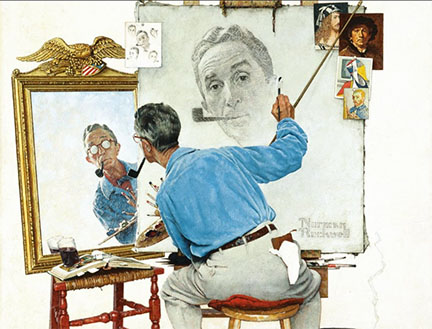“The view of life I communicate in my pictures excludes the sordid and the ugly. I paint life as I would like it to be.”
Norman Rockwell painted the American dream and– for decades—he did it better than anyone else.
For many who grew up and came of age during Rockwell’s time painting cover portraits for such popular magazines as Boy’s Life, Look, and the Saturday Evening Post—not to mention his many illustrations used to advertise products from women’s hosiery to Jell-O – his distinctive style is easily recognizable. While older adults now living with Alzheimer’s disease and other dementias may be unable to identify or place individual Rockwell images, the spirit of his perspective on American life in the mid-20th century still resonates.

Why does the work of Norman Rockwell—over four decades after his death—continue to have such a profound impact on Americans of a certain age? Should dementia caregivers reintroduce Rockwell’s work as a way to create moments of serenity and joy?
Pleasant Imagery
Norman Rockwell’s paintings almost always provided a glimpse into an American life that seemed idyllic; free from concern or conflict. Born and raised in New York City with summers spent in the country, Rockwell’s early work in particular gravitated towards the latter as a way to escape from some of the unpleasant images he saw around him in the city. Sharing Rockwell’s “depictions of the heroes, the commonplace, and the American spirit” with a loved one with dementia as a regularly planned activity—or even intermittently during times of stress and anxiety—can have positive effects. Because his paintings and illustrations so often depict happy situations and interactions, they can spark feelings of contentment to those who take the time to enjoy them.
Recognizable Scenes
You can argue that Rockwell’s depiction of everyday American life was not always a true representation of the times in which he lived and worked. Still his work enjoyed broad appeal during the height of his career and the wholesome images he created seamlessly became woven into the nation’s public consciousness.
Nostalgia can be a powerful tool and Rockwell’s paintings have a knack for bringing back sentimental feelings for those who still enjoy viewing them. Again, even if the exact scene depicted is not recognizable to the viewer, someone living with dementia will likely experience a familiar, positive reaction to seeing the illustration. Some dementia care providers have even started incorporating Rockwell-like scenes into the design of common spaces throughout their buildings to make residents happier and more comfortable.
Keep in mind that nostalgia can foster feelings of longing, which may not be ideal for every situation. Caregivers should use their best judgement when showing images of any kind, even the good natured images Rockwell is known for creating over his five decades-long career.
The Dementia Connection
Rockwell’s work is often integrated into activities calendars at senior housing communities and adult day centers across the country. Again, these timeless images can put people with memory impairment in a more positive state of mind and can even get the most reticent people talking about what they see and the elements of their own lives they associate with the image.
Ironically, Norman Rockwell was himself diagnosed with dementia towards the end of his life, with the disease reportedly robbing him of the ability to create works of art during his final years. It is almost fitting that despite Rockwell’s struggle with the disease; his work stands the test of time and continues to bring joy to so many people living through similar challenges.








